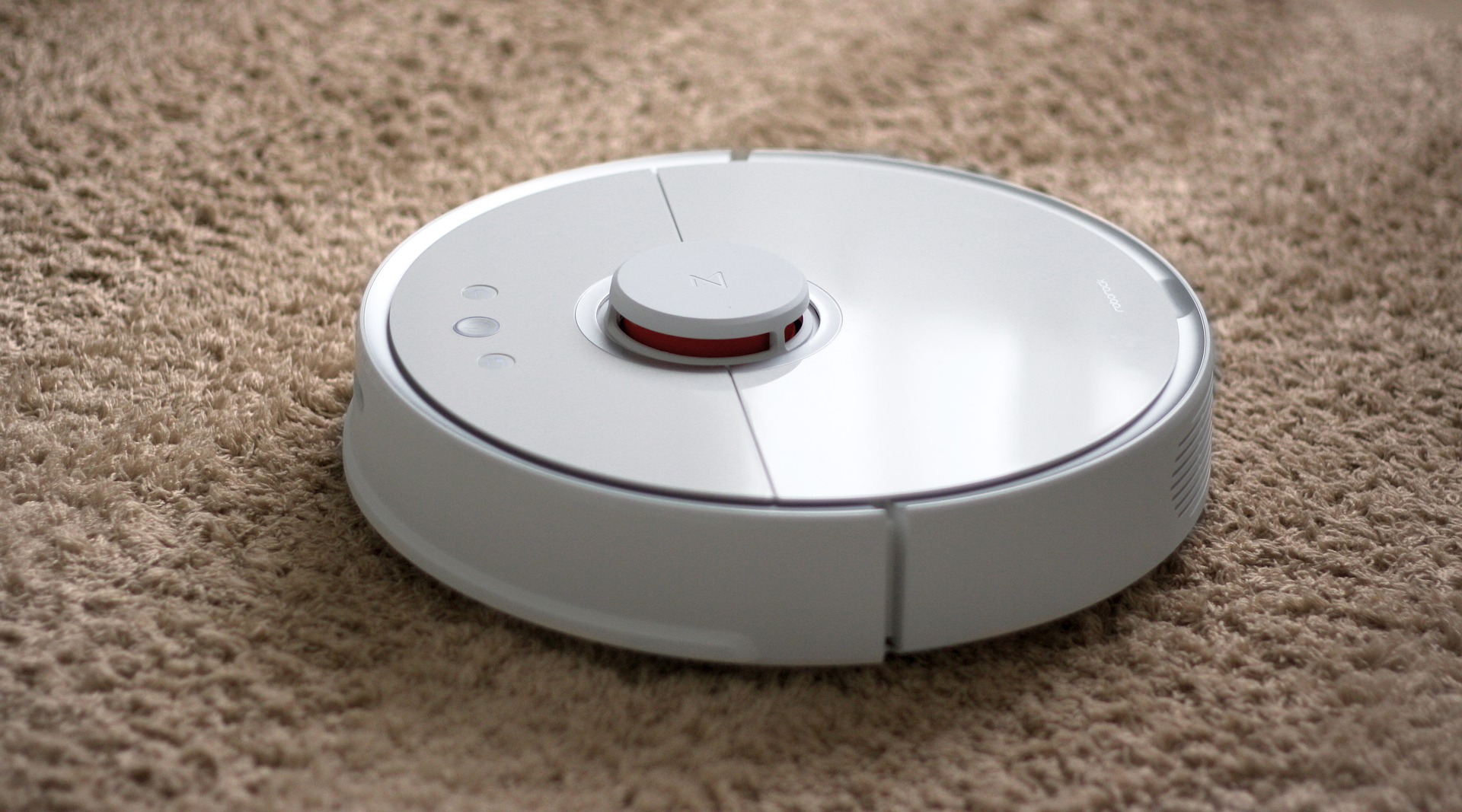Top best ASUS graphics cards in 2022
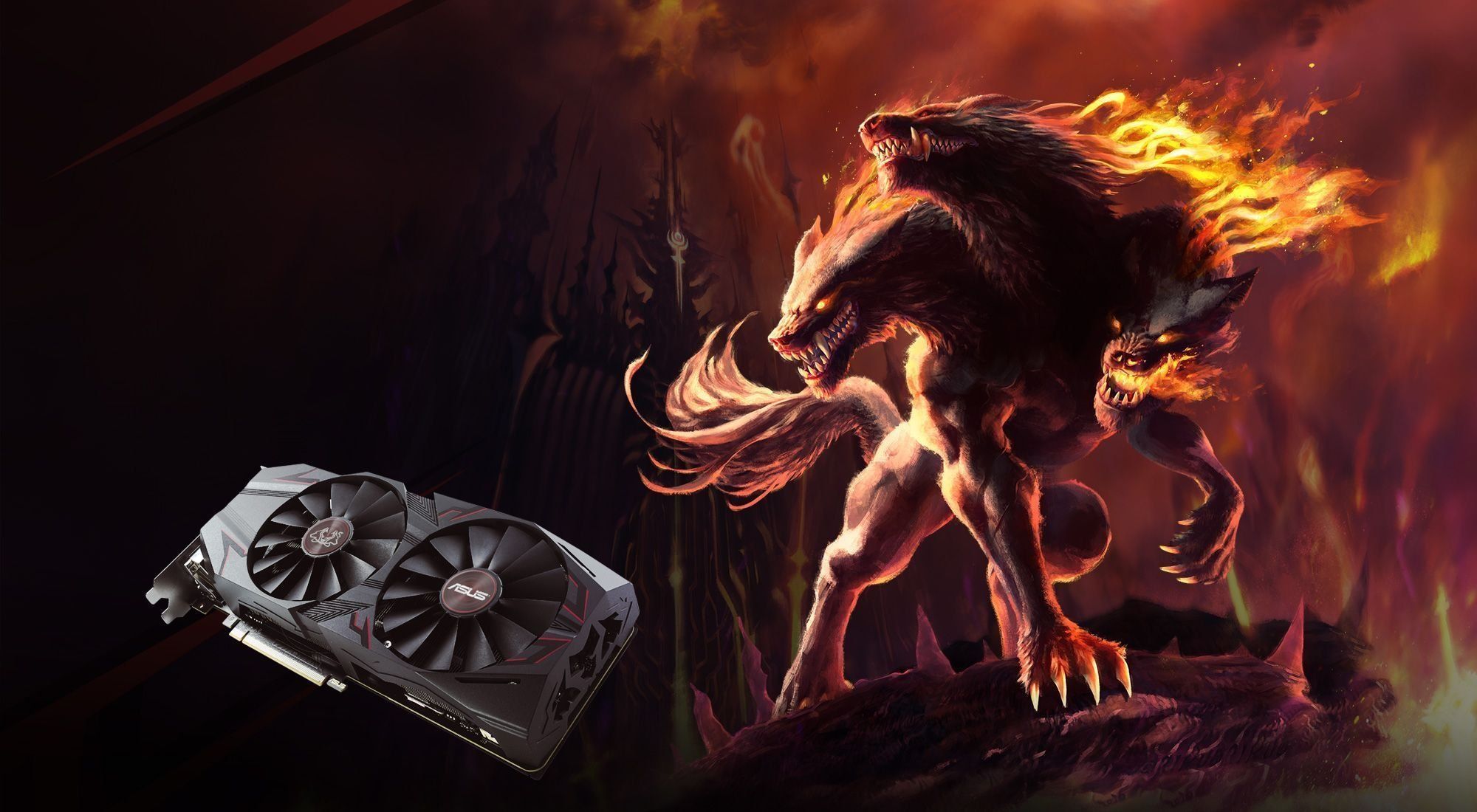
This review will help answer popular questions - which company's video cards are better, what to look for when choosing. It's easier to answer the first question. For more than a decade, the Taiwanese company ASUS has been deservedly considered one of the best video card manufacturers. Here are popular models, very different in price - both inexpensive and the most advanced gaming ones. The popularity of ASUS models is due to the very high quality and reliability of manufactured computer components. Next, we consider in detail the functionality and characteristics of video cards.
Content
How to choose a video card
But first, let's answer the question - how to avoid mistakes when choosing a video card for a computer? First of all, you need to decide for what purpose you need a computer. It's one thing if you need it to work with a text editor, spreadsheets and the Internet. Then the most inexpensive card will do, and you can get by with the built-in one. If you need the most modern games to run with maximum settings so that you can connect virtual reality devices, then the more expensive the card, the better.
The following types of video cards can be distinguished:
- budget or office;
- middle level;
- gaming.
Budget video cards can be both integrated and discrete. In integrated video adapters, most often the central processor takes over the entire function of displaying the image on the screen, less often - a separate microcircuit on the motherboard. Such built-in video adapters are used for laptops, as well as for personal computers, for which there are no special requirements for a graphics system.
If the computer is supposed to be widely used in games, graphics, virtual reality, then it is advisable to use discrete cards, which are separate boards installed in a special computer slot.This review provides a description, characteristics and comparison of just such video adapters.
What are the criteria for choosing video cards? The performance and consumer characteristics of video adapters are affected by the following indicators:
- The frequency of the video processor. This is an important indicator, but it cannot directly judge the power of the video adapter. The role is played not only by the frequency, but also by the number of shader units included in the adapter.
- Video memory frequency and type. Most devices are equipped with modern GDDR5 memory, although there are also budget models based on GDDR3. GDDR6 memory is installed on the latest generation video cards.
- The amount of video memory. It is clear that the more memory, the better. Although budget cards in a large amount of memory does not make much sense.
- Bit width of the video memory bus. Even with a powerful video processor and a large amount of video memory, insufficient bus bandwidth can become the bottleneck that will slow down the entire video system.
- Cooling system. It is important that the cooling system works efficiently and quietly. Otherwise, performance, service life and operating comfort may be reduced. Use passive, active and even water cooling.
- Energy consumption. It is very important that the recommended power wattage is observed so that the computer's power supply meets the requirements of the video card. Otherwise, the computer simply will not work.
- Technical process. What does this indicator affect? For power consumption and heat dissipation. The more modern the technical process, the easier it is to ensure effective cooling and power supply for the video card. The latest generation of video cards are already manufactured using 12 nm technology, budget ones - 28 nm.
- Number of supported monitors and other devices.This indicator is important for those who work professionally with graphics or are going to use virtual reality devices.
- Dimensions. The number of slots occupied by all video cards is different. Therefore, you need to make sure that the adapter fits in the case and does not interfere with other devices.
Budget video cards (up to 10,000 r)
The rating of high-quality ASUS video cards opens with five budget models, ranging from the most inexpensive ones designed exclusively for office needs to video cards with which you can even play some games.
15 ASUS Radeon R5230-SL-2GD3-L
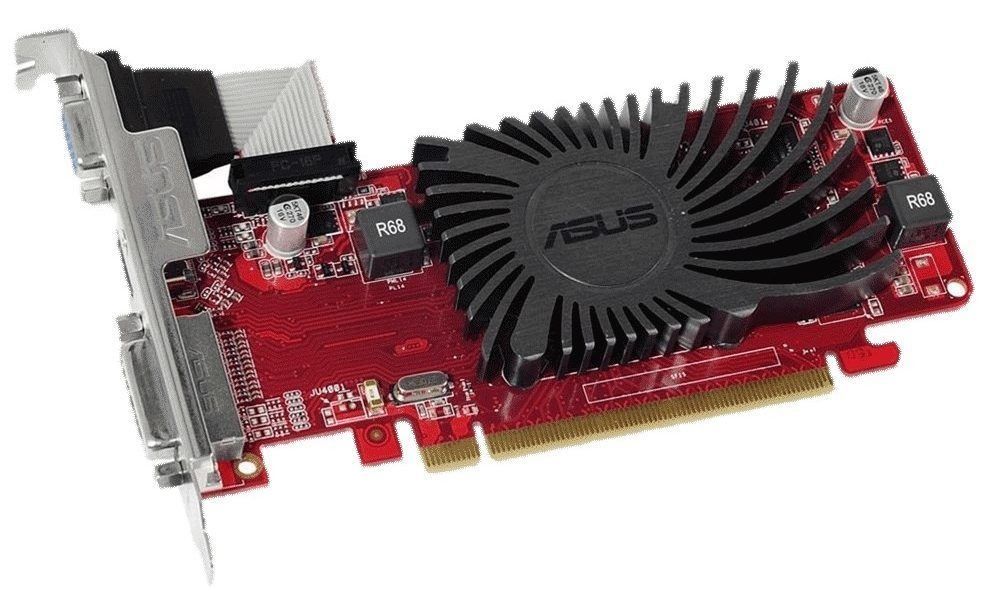
ASUS Radeon R5230-SL-2GD3-L is a very budget solution for those who just need a video card because, for example, the old one has broken. It's a solid, quiet, low profile office card with old slow memory. Not suitable for gaming at all.
The frequency of the video processor is 650 MHz. Memory 2 GB GDDR3 operates at a frequency of 1200 MHz, 64-bit bus.
Average price: 3,500 rubles.
- silent operation;
- small sizes;
- not demanding on the computer's power supply;
- very low cost.
- very poor performance.
14 ASUS Radeon R7240-OC-4GD3-L
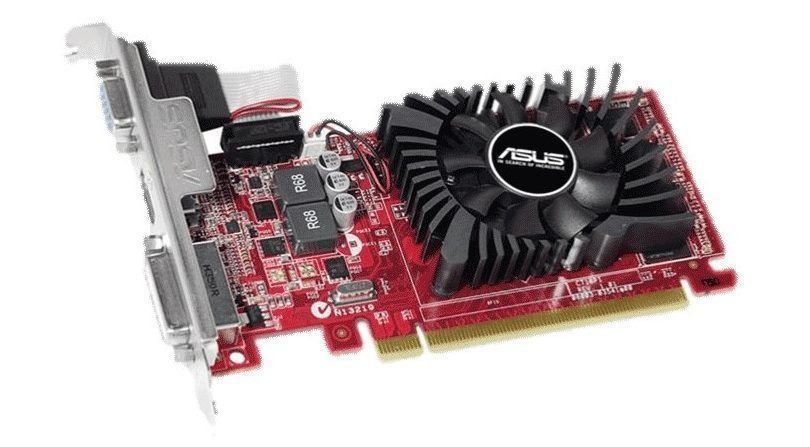
The video card is equipped with 4 GB of video memory, which is good for its price. But the memory is slow - GDDR3, only 900 MHz. The processor is also not fast - 770 MHz. Bus - 128 bits. The card has three interface connectors - HDMI, VGA and DVI, but only two monitors can be connected at the same time. The board is small, with low power consumption.
Average price: 8,000 rubles.
- small dimensions;
- quiet fan;
- not demanding on the computer's power supply;
- low cost.
- slow memory;
- poor performance.
13 ASUS GeForce GT730-SL-2GD5 BRK
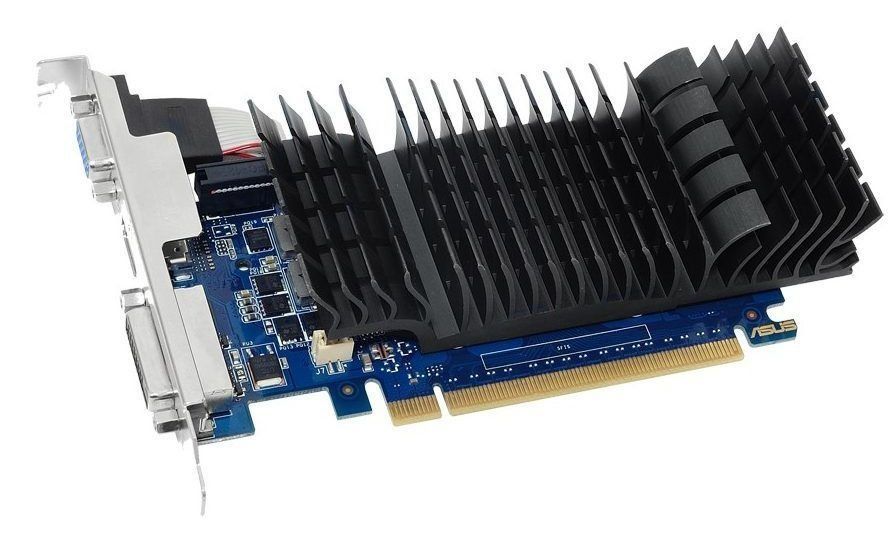
This video card is a good solution for an office computer. It has a small size, it is suitable for any PC. It uses an efficient and silent passive cooling system. You can significantly overclock the graphics chip and memory, but you need to provide additional cooling to the card.
GPU frequency 902 MHz. The amount of memory is 2 GB, the type of memory is GDDR5, the memory frequency is 5 GHz, the bus is 64 bits.
Average price: 6,000 rubles.
- silent operation;
- small sizes;
- good potential for overclocking while providing additional cooling;
- not demanding on the computer's power supply;
- low cost.
- poor performance.
12 ASUS GeForce PH-GT1030-02G BRK
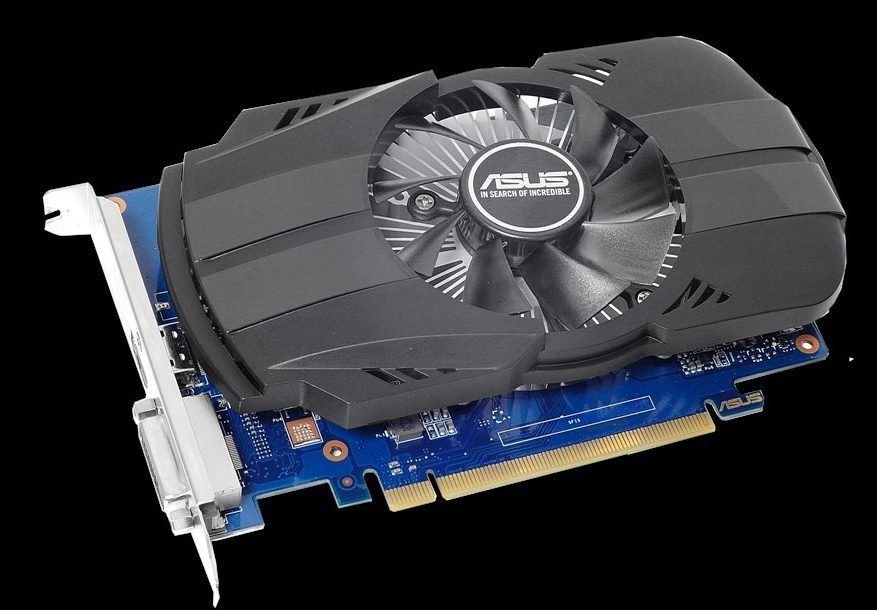
ASUS GeForce PH-GT1030-02G is an entry-level video card with a good low-noise fan on ball bearings.
The base frequency of the GPU is 1278 MHz, Boost Clock 1531 MHz. Memory 2 GB GDDR5 operates at a frequency of 6 GHz, 64-bit bus.
Average price: 6,500 rubles.
- small sizes;
- low-noise fan with extended service life;
- low cost.
- poor performance.
11 ASUS GeForce PH-GTX1050-2G
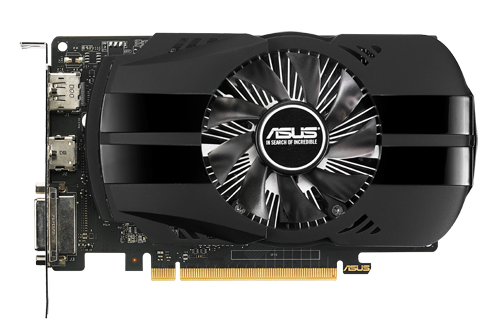
ASUS GeForce PH-GTX1050-2G can already be considered a gaming card, but an entry-level one. In most games, you can achieve acceptable speed in FULL HD resolution. The video card has an efficient low-noise cooling system, it does not need additional power. A reliable fan with two ball bearings is installed here. The board is small and suitable for compact computers.This is a good and cheap video card.
GPU base clock 1354 MHz, Boost Clock 1455 MHz. Memory 2 GB GDDR5 operates at a frequency of 7 GHz, bus 128 bits.
Average price: 10,000 rubles.
- small size;
- not demanding on the computer's power supply;
- low noise fan with extended service life.
- relatively low performance.
Mid-range video cards (up to 30,000 r)
Video cards of the middle price category are suitable not only for office applications, but also for graphics, for Photoshop. On computers with these cards, you can comfortably play most games at medium settings.
10 ASUS GeForce ROG STRIX-GTX1050TI-O4G-GAMING
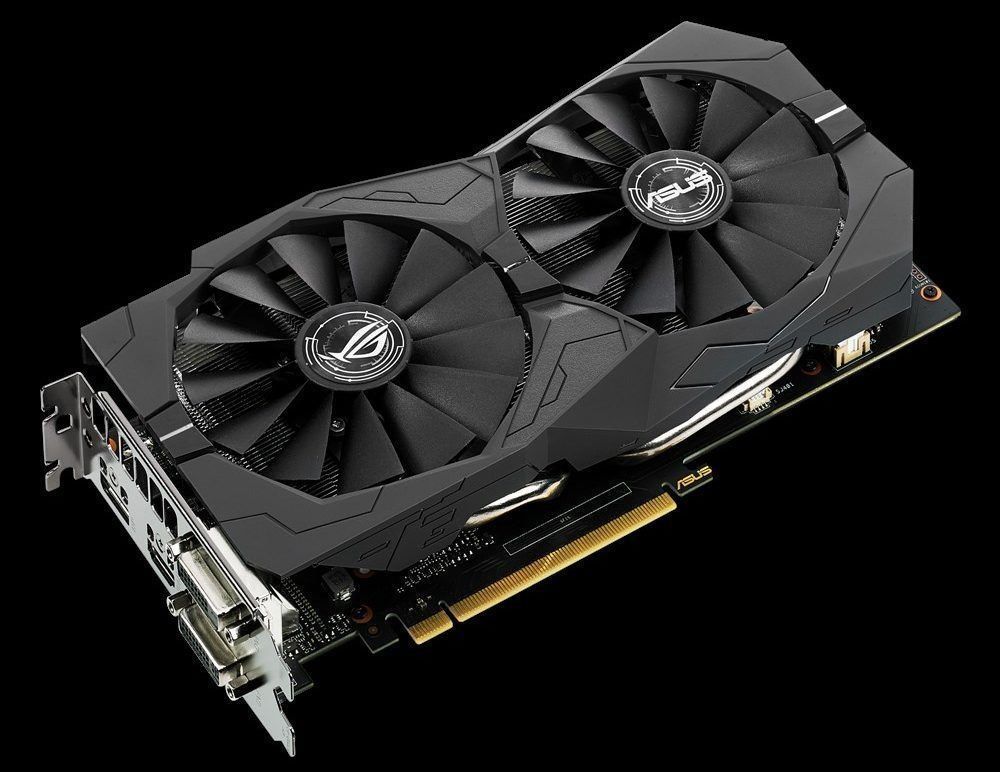
This card shows excellent results for the GeForce GTX1050TI chip. It has increased frequencies - base 1392 MHz instead of 1290 MHz, Boost Clock 1506 MHz instead of 1392 MHz. The memory frequency is 7008 MHz, the bus is 128 bits.
The video card has a powerful cooling system that does an excellent job not only at factory frequencies, but also during overclocking. At the same time, the temperature does not rise much, and the fans do not make noise. This is the fastest card in the GTX1050TI series and one of the best overclocking solutions.
Average price: 15,000 rubles.
- high factory frequencies;
- good overclocking potential.
- relatively low performance.
9 ASUS Radeon ROG-STRIX-RX570-O4G-GAMING

This graphics card, like all cards in the ROG gaming line, is slightly overclocked at the factory compared to other cards based on the Radeon RX 570 processor. This provides a few percent performance boost.
The video card has a massive heatsink with two large fans. But with an increase in the load on the card, the cooling system behaves quite noisily. Although the card has a good potential for overclocking, you have to put up with the discomfort caused by increased fan speeds.
The base frequency of the GPU is 1.3 GHz. Memory 4 GB GDDR5 operates at a frequency of 7 GHz, the bus is 256 bits.
Average price: 15,500 rubles.
- high factory frequencies;
- efficient cooling system;
- good overclocking potential.
- relatively low performance;
- high noise;
- big size.
8 ASUS GeForce PH-GTX1060-3G
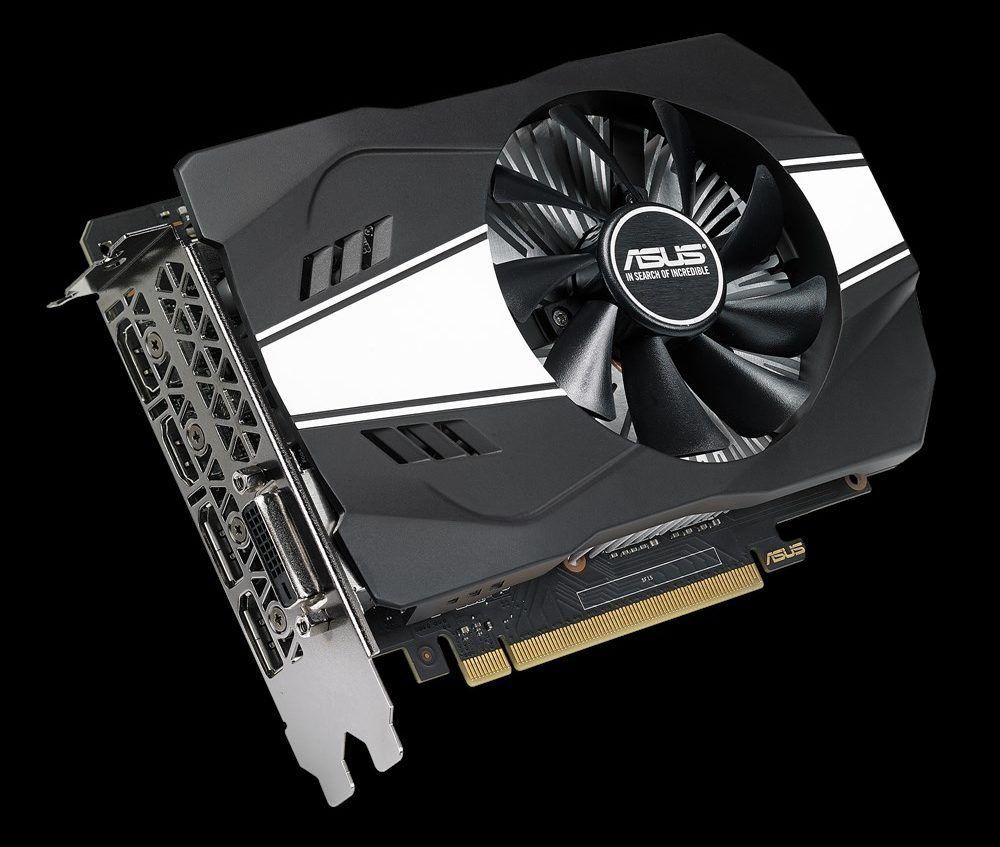
The video card has acceptable performance at a relatively low cost. It allows you to play most popular games at 60 FPS, even if not at maximum resolutions. The card has a mini form factor and will fit in almost any computer. And the card has no special requirements for the computer's power supply, since it is very energy efficient. It uses a durable and low-noise ball-bearing fan.
The card has 3 GB of GDDR5 memory running at 8 GHz, the bus is 192 bits. GPU base clock 1506 MHz, Boost Clock 1708 MHz.
Average price: 17,000 rubles.
- small size;
- not demanding on the computer's power supply;
- low noise fan with extended service life.
- relatively low performance.
7 ASUS Radeon ROG-STRIX-RX580-O8G-GAMING
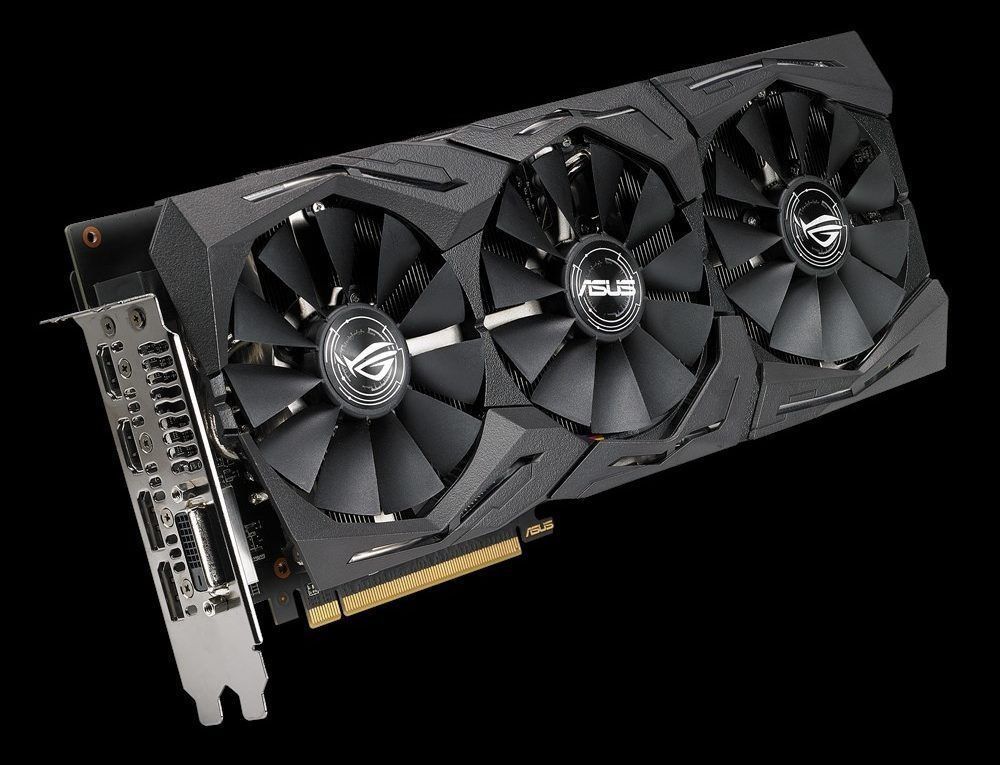
Tests of this video card showed that it is one of the fastest on the Radeon RX580. The device looks spectacular - dark metal, black plastic and RGB backlighting. The card has a highly efficient cooling system consisting of a powerful heatsink with three fans. This allows you to successfully overclock the card and get a noticeable performance boost.
The card supports Fully VR Ready technology, ie. has an additional HDMI port for connecting virtual reality devices and has enough power for VR playback. The video card without problems provides 60 FPS in all games in 1080p resolution and acceptable speed in 2K resolution.
Average price: 26,000 rubles.
- high speed in 2K;
- 8 GB memory;
- good potential for overclocking;
- efficient cooling system;
- backlight.
- increased power consumption;
- big sizes;
- expensive for a Radeon RX model
6 ASUS GeForce ROG STRIX-GTX1060-O6G-GAMING
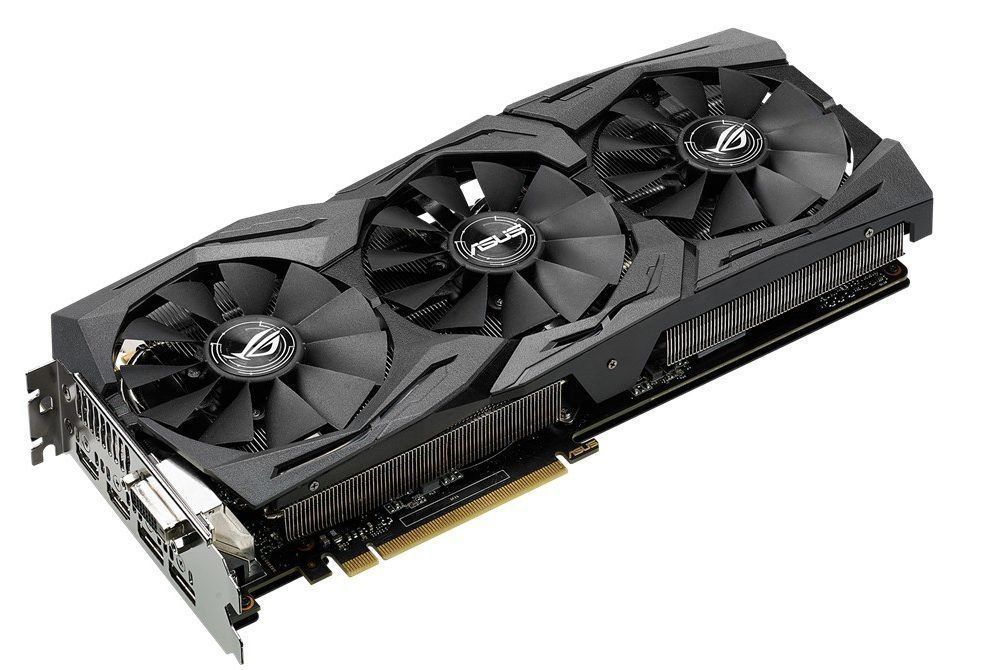
The video card looks very solid due to the large heatsink with three large fans and reaches a length of up to 30 cm. The card is based on the GeForce GTX 1060 chip, but the same cooling system is installed here as in the older models of the STRIX line on the GTX 1070 and GTX 1080. Naturally, the cooling system works flawlessly on a cooler card. The card heats up slightly and does not make noise.
The video card is equipped with five connectors: HDMI - 2 pcs., Display Port - 2 pcs., DVI - 1 pc. An additional HDMI port allows you to easily connect a virtual reality system.
The base core frequency of the video card is 1645 MHz, Boost Clock is 1873 MHz. This is an increased frequency compared to the basic characteristics of the chip. The 6 GB GDDR5 memory is also overclocked to 8200 MHz instead of the stock 8000 MHz. The bus is 192 bits.The card has good potential for further overclocking. All this gives a significant performance boost.
Average price: 27,000 rubles.
- high factory frequencies;
- good potential for overclocking;
- efficient cooling system.
- big sizes.
The best video cards
At the top of the top are five gaming graphics cards that support virtual reality systems and the latest games. They are ideal for both the gamer and the 3D graphics designer. Here are both tried and tested video cards that received excellent reviews, as well as new ones. In particular, the top 5 includes two cards that use the new generation of NVIDIA GeForce RTX20xx GPUs.
5 ASUS GeForce CERBERUS-GTX1070TI-A8G
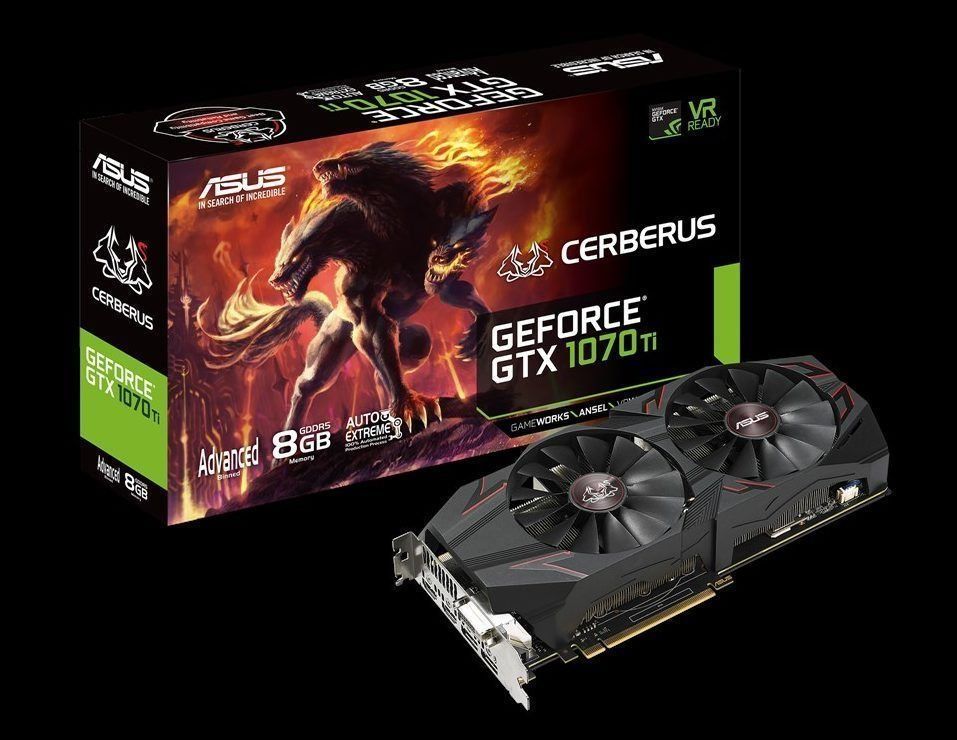
The video card comes in a colorful box, which depicts a fire-breathing dog with three heads. This line of video cards is named after him. The GeForce GTX 1070 TI chip is not much inferior to the GTX 1080. Considering that the video card overclocks well, it is generally not inferior to 1080 cards during overclocking, while being cheaper.
The video card has a large heatsink with two powerful efficient fans. The non-overclocked chip frequency is 1670 MHz, the average Boost Clock is 1746 MHz. 8 GB of memory operate at a frequency of 8014 MHz. The card has good indicators of both performance and power consumption and heat dissipation.
The ASUS GeForce CERBERUS-GTX1070TI-A8G is an excellent card with no problems when playing at WQHD resolution. If you overclock the card, you can get the performance of the more expensive Radeon RX Vega 64 or GeForce GTX 1080.
Average price: 39,000 rubles.
- high performance;
- good acceleration;
- high energy efficiency.
- high price.
4 ASUS GeForce TURBO-GTX1080-8G
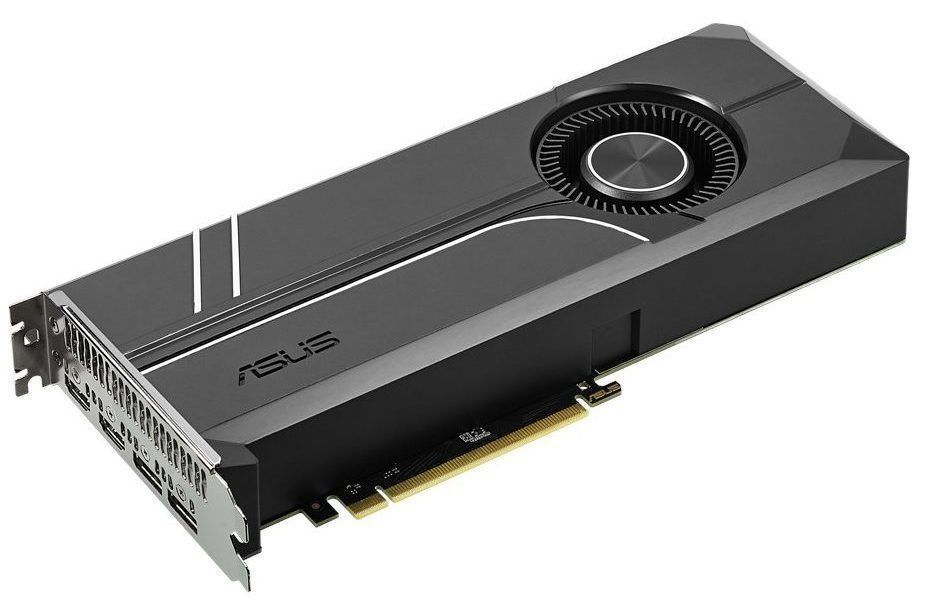
Until now, this video card remains the leader of all ratings on the Internet, although its more nimble competitors have already come out. Nevertheless, its performance is enough so that the toughest gamer does not feel flawed. Everything goes on it and at the maximum.
The 1733 MHz GPU and 8 GB of fast GDDR5X memory will not only allow you to play all the games at the maximum, but also solve serious tasks related to the work of graphic applications. This is a very powerful fan card with increased reliability. Here ball bearings are used instead of plain bearings, which are usually used in coolers.
Average price: 43,000 rubles.
- high performance;
- efficient heat dissipation;
- low-noise fan with extended service life;
- good overclocking potential.
- difficult to find on sale;
- high price.
3 ASUS GeForce DUAL-RTX2070-O8G
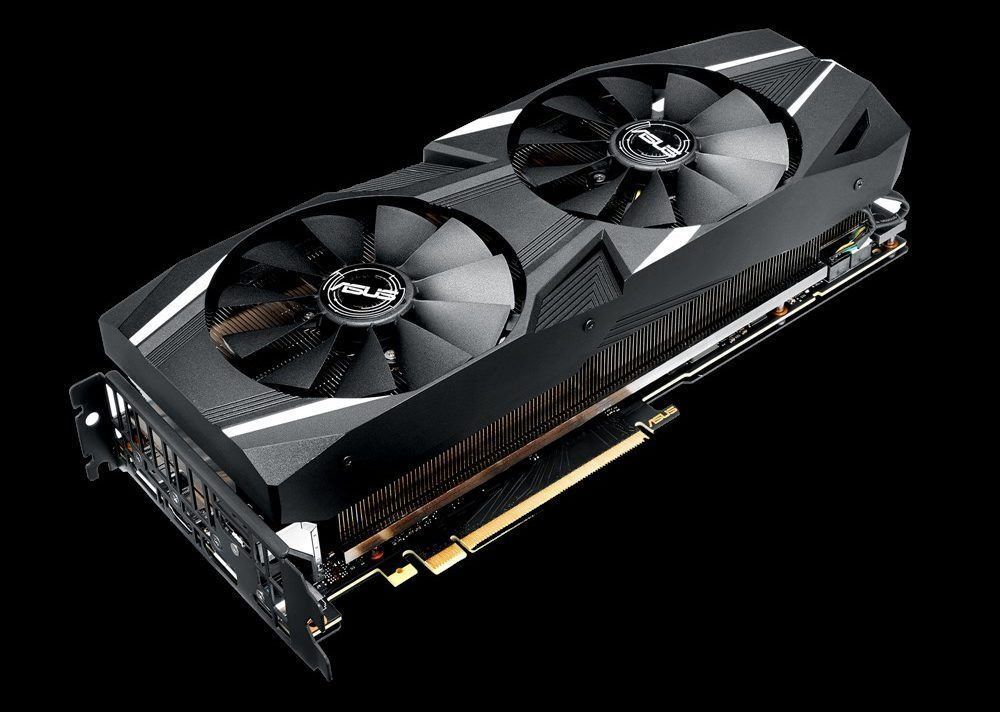
The GeForce DUAL-RTX2070-O8G graphics card is an advanced solution for gaming and 3D graphics. The card is large due to the massive heatsink, on which two patented Wing-blade 100mm fans are installed. Coolers do an excellent job of cooling and make little noise even under high load.
This version of the card slightly exceeds the standard frequencies of the RTX2070 chip. It has a core clock of 1410 MHz and an average Boost Clock of 1710 MHz. This allows you to achieve acceleration in games up to 5%. The card has the potential for further overclocking. In this case, you can achieve a performance gain of up to 10%.
A nice bonus is the presence of a power adapter and a six-month subscription to the Wtfast program, which can speed up some online games.
Average price: 50,000 rubles.
- high performance;
- support for the latest RTX technologies;
- high energy efficiency;
- quiet work.
- while the software is not sufficiently optimized for the card;
- high price.
2 ASUS GeForce TURBO-GTX1080TI-11G
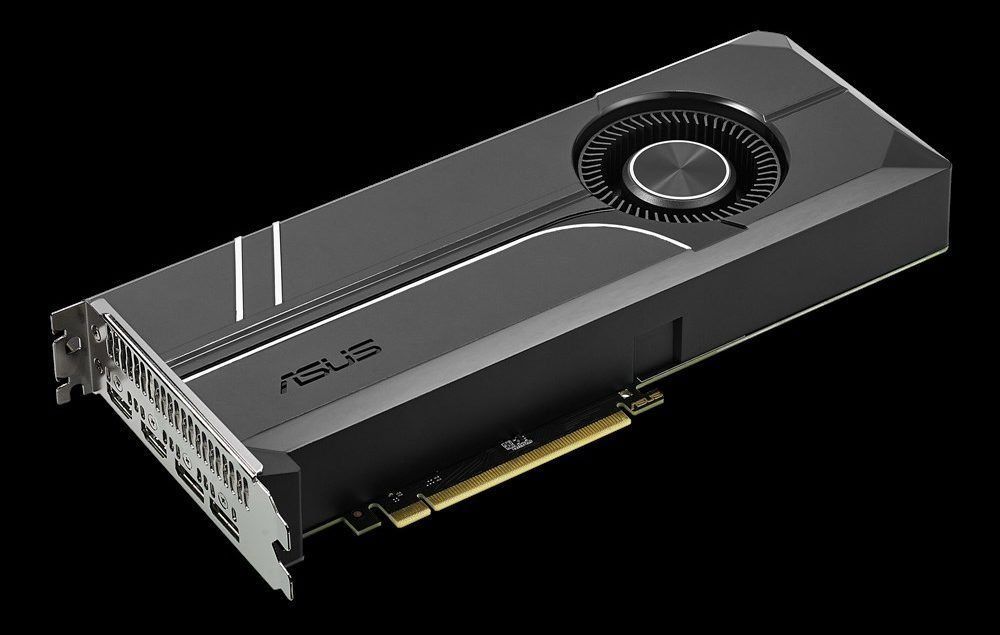
The ASUS GeForce GTX 1080 Ti Turbo graphics card is a device for real gamers. It uses the low-noise and efficient ball-bearing fan with an extended service life, traditional for the TURBO series. The card is ideal for traveling in virtual reality. This is facilitated by support for NVIDIA VRWorks technology. The card has two HDMI ports. You can connect both VR equipment and a monitor at the same time. The card looks stylish on its own, but the Asus logo is still highlighted on it, which can be replaced with some other one.
The card has on board 11 GB of GDDR5 memory and a 352-bit bus. This ensures both excellent quality of games and high speed of work with 3D-graphics. Huge monitors can be connected to the card, as it supports a resolution of 7680 by 4320 pixels.
Considering the high cost of the video card, its poor bundle is surprising. Only two utilities are supplied with the card - GPU Tweak II for tuning and overclocking and XSplit Gamecaster for recording and broadcasting games to the Internet. There are no adapters, connectors and no games in the delivery.
Average price: 78,000 rubles.
- high performance;
- 11 GB memory;
- fan with extended service life;
- 2 x HDMI and Display Port.
- poor equipment;
- difficult to find on sale;
- very high cost.
1 ASUS GeForce DUAL-RTX2080-O8G
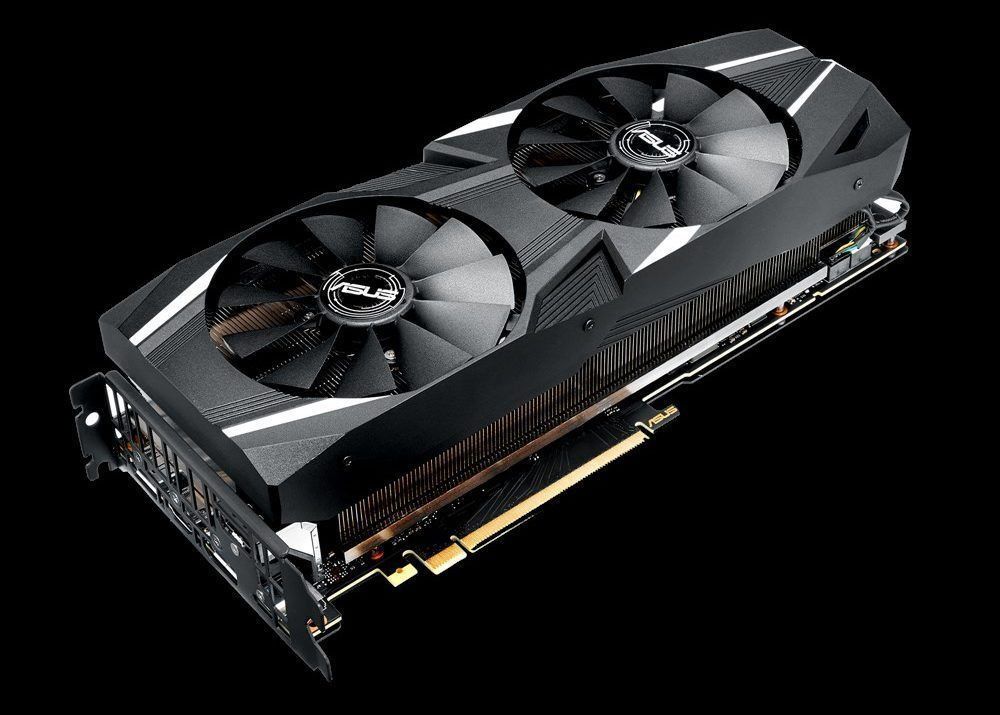
ASUS GeForce DUAL-RTX2080-O8G is a new product from ASUS, and it immediately impresses with its dimensions - 26.8 x 11.4 x 5.8 cm. The card has a 2.7-slot form factor, which allowed one and a half times increase the heatsink area compared to previous generations of graphics cards. The radiator has two large 100mm fans that turn on when the threshold reaches 55 degrees. The card has a lot of interface connectors - DisplayPort 3 pcs., HDMI and Type-C port.
Especially the graphics card impresses with its performance. This is the most powerful card in our ranking. It is on average 1.5 times faster in 3DMark than cards based on the GTX 1080, and 10% faster than the GTX 1080 Ti. True, in other tests the difference is not so impressive, in some of them the GTX 1080 Ti is not inferior. Obviously, the software is not yet able to fully reveal all the capabilities of the new chip.
Average price: 75,000 rubles.
- very high performance;
- support for the latest RTX technologies;
- high energy efficiency under load;
- silent operation without load;
- many different interface ports.
- increased power consumption without load;
- insufficiently optimized software;
- very high cost.
The choice of a video card should be made based on the requirements that ultimately apply to your PC. And ASUS is able to offer video cards of various capacities and price categories.
new entries
Categories
Useful
Popular Articles
-

Top ranking of the best and cheapest scooters up to 50cc in 2022
Views: 131661 -

Rating of the best soundproofing materials for an apartment in 2022
Views: 127700 -

Rating of cheap analogues of expensive medicines for flu and colds for 2022
Views: 124527 -

The best men's sneakers in 2022
Views: 124044 -

The Best Complex Vitamins in 2022
Views: 121947 -

Top ranking of the best smartwatches 2022 - price-quality ratio
Views: 114985 -

The best paint for gray hair - top rating 2022
Views: 113402 -

Ranking of the best wood paints for interior work in 2022
Views: 110328 -

Rating of the best spinning reels in 2022
Views: 105335 -

Ranking of the best sex dolls for men for 2022
Views: 104375 -

Ranking of the best action cameras from China in 2022
Views: 102224 -

The most effective calcium preparations for adults and children in 2022
Views: 102018




